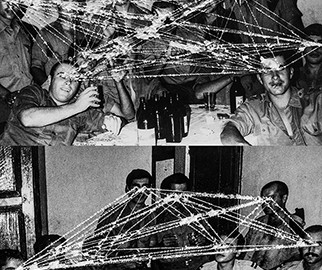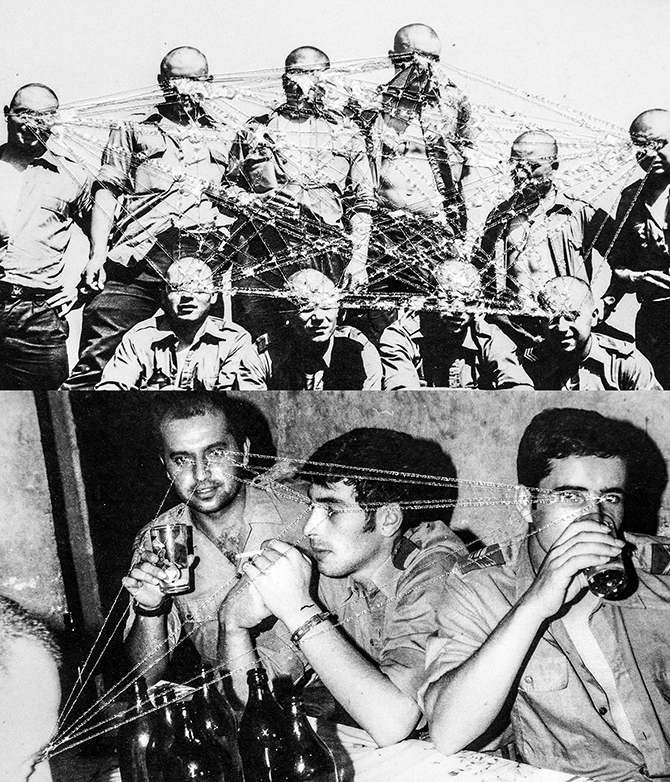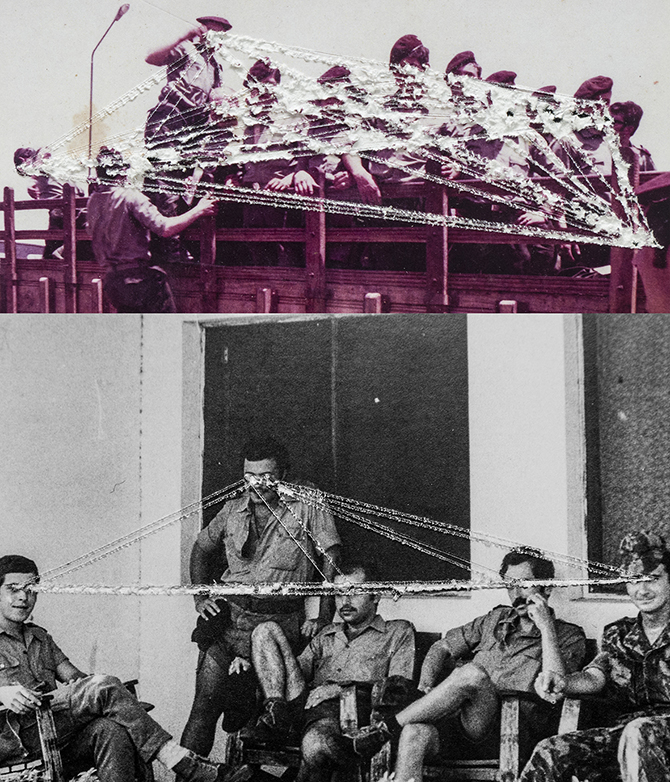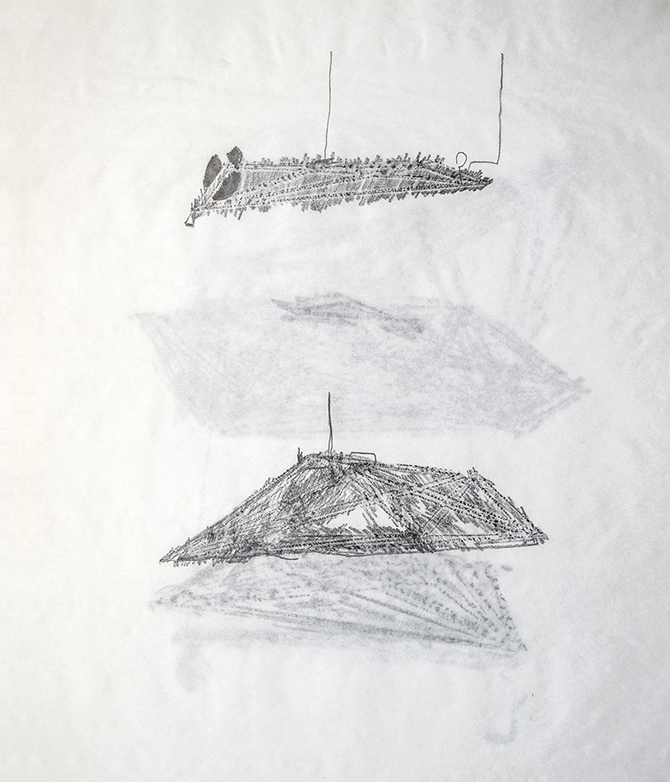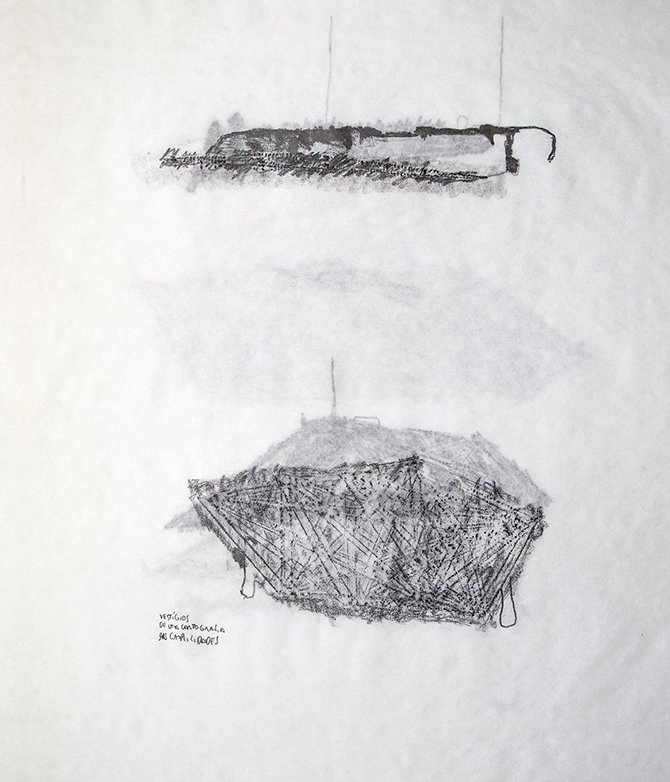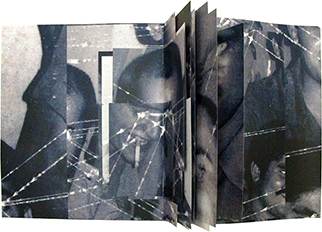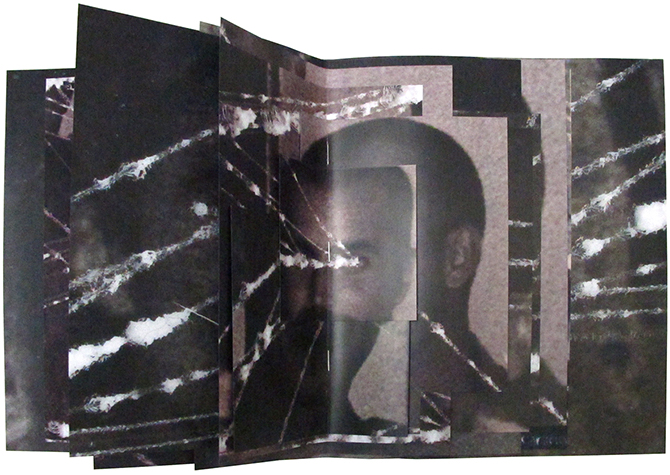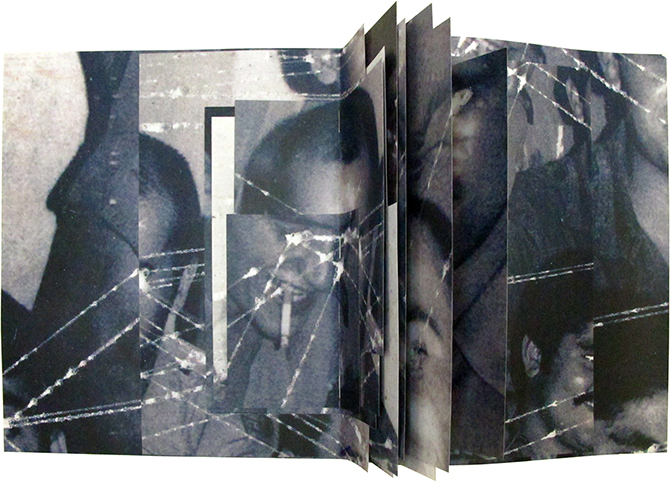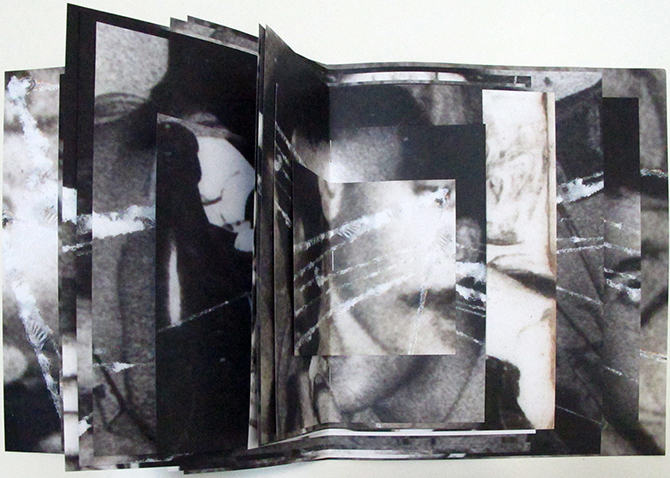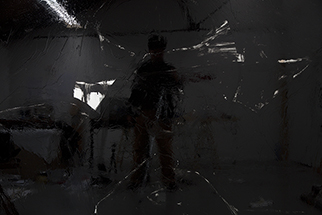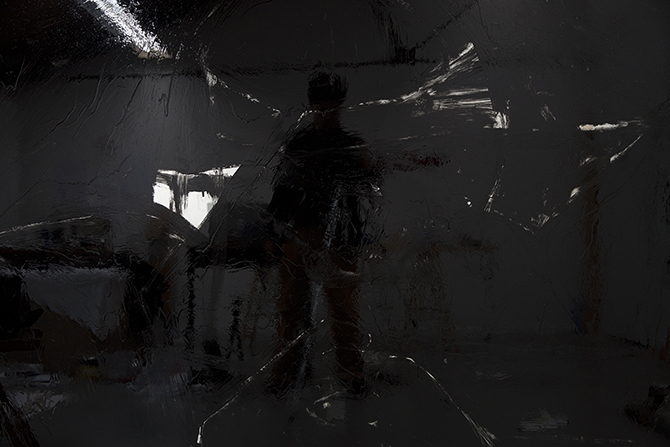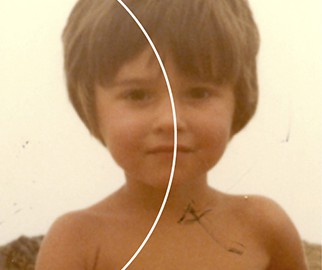PARFOIS, LE PORNO, C’EST BON [1]
Memory, pornography, and blindness in the latest films of Daniel Barroca
Ricardo Nicolau, March 2005
Translated by Ana Yokochi
Every one of us has watched TV shows with the sound turned off. We only have to remind ourselves of the experience of talking to someone in a bar while peeking at the pictures parading behind that person’s back – and many bars keep television sets constantly turned on, yet muted, while some other music plays in the background. In a way, those images work as a sort of continuous visual track – much in the same way as background music –, and risk being called ‘elevator’ or ‘airport images’, just like what happened to the music. We all know how ridiculous and perplexing, almost foolish, those images can be – especially when combined with a sound track that takes them out of context. The only chance to escape the grotesque would imply our filling the absence of sound with our memory. But even if we could, we would be forced to admit that sound has a fundamental role, as much as the unfolding of the images, in the building of narrative possibilities[2].
The experience of muted visuals also implies the awareness of the obscene character of certain images, or of certain shots, with their dissecting role amplified by the lack of sound. Watching a close-up of a talking face, gestures we do not understand, an inventory of expressions, everything that is softened by the regular perception experience becomes almost pornographic.
* * *
Daniel Barroca (Lisbon, 1976) has worked in a parallel and in an articulate way with drawing and video. His works on paper and other media pursuit a common interest about our perceptive apparatus and in the role of memory in the filling the gaps of sensory or narrative character. Hence, and against a kind of doxa of pure visual imagery, the artist always rejects the most accurate, clear and focused images. Daniel confronts our desire of wanting to see every thing, in every way and from all angles – which is widely sponsored by many examples of image regimes, from photography to cinema – with filters, stains, frictions to common visualisation.
His two latest works, filmed footage that was later digitalised, work as a series (perhaps to be continued?). The images were not filmed by the artist but were substantially transformed by him – to say the least, as we shall soon find out why. What we see at first, while our perceptive apparatus adapts, is a vibration translated into many spots – as if we had repeatedly rubbed our eyes, or as if we had kept them shut under an extremely intense light –; or as if in a cinema museum we were watching the projection of film fragments in a complete state of decay. We watch an endless parade of black spots on the screen, spreading out or shrinking, ruthlessly filtering a light source that never gets to show the image. For a while we only realise there is a tension between the bursts of energy and the pure abstraction, and latent figuration. Slowly, we begin to understand that the spots hide (for they do not hide completely) a series of men and women dressed in out-of-fashion swimming suits and who are enjoying some leisure time by a swimming pool. The light source is none other but the sun, which seems scorching and typical of a harsher climate than the Portuguese.
Daniel started of with a home movie, recorded on super 8, which he found accidentally, forgotten in a projector. These are the images of a group of people doing what is usual done at a private swimming pool (a playground par excellence): mostly nothing. They dive, they swim, they chat, and they sunbathe – half a dozen sleepy numb-limbed cats. In terms of narrative, these images captured on a single set and with very few angles are, of course, tremendously insipid.
The spots that appear in the movies that Daniel Barroca now exhibits at the Politécnica were painted by the artist directly on the film, meticulously placing them in what resembles a real jewellery work. The film was then translated into digital form. From a strictly visual point of view, the results seem to echo some experiences mainly from the 1960s and 70s that are known under the generic designation of Experimental Cinema[3]. However, this work by Daniel Barroca, in spite of some obvious formal approaches, couldn’t be further away from a nostalgic revisiting of some cinema of the past – independently of his interest in films such as the ones of Jonas Mekas or Stan Brakhage. Let us start with the resemblance: the absence of narration, the settling of a rhythm of vision alienated from the story, the attention to the physical reality of the film (i.e. the actual film), a disjunctive treatment of the image/sound. The obvious distances: Daniel isn’t interested in reflecting about the peculiarities of the medium or in exploring all the possibilities of the devices for recording and projecting films. These are features common to many experiments of the so called experimental cinema, and which coincide under two other umbrella-definitions that have catalogued film and video: structuralist cinema and expanded cinema, two forms of intended abortion of the magic of cinema[4].
In these movies, it is clear that there is a targeting of the film, of its physical element, but unlike what happens with many of the so-called experimental films, the artist doesn’t catalogue potential effects during the shooting and editing of the images: overexposure, out-of-focus, moving the camera around; and of the recording and projection devices, intermittent stills and frantic sequences… there is an unending list.
It seems clear to me that the two main qualities of these films near the swimming pool, which fascinated the artist, correspond to a confluence between the intimate character of the images – recorded to be seen in an exclusively domestic context – and the total loss of references that could give them any context, or insert them in a specific story (they are shreds of personal stories), after having been made to circulate outside their particularity. We must also remember that they are silent – and I haven’t yet mentioned a fundamental issue: Daniel Barroca decided to call these video works Barulho (Noise) – but we will come to that.
* * *
We immediately realise, although the more or less expanded and intermittent blackness allows us to see very little of the original film, that we are before a home movie: the characteristic grain of the image, the roughness of the angles, the unsophisticated editing and the sunburned colours typical of the home movies of the sixties and seventies.
The first time I saw those images, with the film already heavily altered, they seemed, even if only for a moment, excerpts of a pornographic movie – the preamble, the small piece of narrative just before the central theme. Why? Mostly, I believe, due to the concentration of half naked bodies, the granularity of the image, the anachronism of the hairstyles and the few clothes that show (as if porn and obsolescence always came together), and the thin narrative. However, these explanations, which are somewhat obvious, don’t seem to be enough. I believe the main reason lies in the absence of sound matching the images (expectable, at least) – this is what was intolerable –, in the fact that I couldn’t hear the dialogue, the interpellations. Because I was denied access to a strictly anecdotic side, to a narrative, even a bad one –, and because I was before a mere display, a mere parade. At some point, this more or less thorough, mute inventory creates an embarrassment, a feeling of having intruded (watching everything without jeopardising the eyes).
By obliterating the images, by making them disappear step by step, but always leaving some traces behind, Daniel Barroca is also placing barriers to the visualization. In this way, he is enhancing this desire to see everything that eventually turns into obscene – and when I speak of obscenity, of pornography, I’m not strictly referring to a specific subgenre of the movie industry, but to a parity of regime between porn and movies (a kind of ontological obscenity of cinema, that relies on the close-up, on the parade, on the thoroughness of the inventory, on the sponsoring of the need to see everything)[5].
Certain details, when watched carefully, may give away the origin of the movie: the intense light, the details of the surrounding landscape, an ease that was unusual in Portugal in the 1960s/1970s, the uninhibited bodies… all these indicate that the images were recorded in a former Portuguese colony.
It is interesting to realise that the oblivion of our colonial past, a part of our history that has been subject to little reflection – and rarely used by the artists (to the point that the few exceptions seem to me to have been automatically overrated) – has its counterpoint in an avid collecting behaviour from the so-called ‘retornados’[6]. There is an intense hunt for these movies, photographs, postcards, and it is this search that has made these images of the former colonies one of the most prized among resellers and second-hand book sellers. There is a niche of collectors who are completely nostalgic of that lost world and who are willing to pay the necessary price to fill in all eventual gaps in their memories – even if, paradoxically, this means that family albums are torn apart, and that previous collections are shuffled and new orders and classifications are created. The fact is that, through photographs and postcards, there is an incredible amount of micro-narratives in circulation, shreds of individual histories that are impossible to refit into the set that gives them a full and unique meaning. For an iconography of Portugal overseas, the images of swimming pools cannot be undervalued, either due to their quality or due to quantity. On the reverse of some swimming-pool postcards, namely from the former colonies, we can usually find: the typical best wishes for the recipients, personal and season’s greetings, the scheduling of rendezvous, accounts of parties with other family members or mutual friends, as well as of trips across the country or nearby countries (such as South Africa), notices of new addresses and telephone numbers, and, of course, notes of homesickness – obviously more frequent in this case than in the postcards sent while vacationing (a view of the swimming pool and the hotel, often with an X marking the exact window of the room where the vacationer is staying in).
Therefore, we have the summing up of memory as an omnipresent scenario in these videos by Daniel Barroca. In two different, but complementary, senses: on the one hand, the artist is interested in the gaps that drive (as much as they prevent) the reconstruction of other people’s stories. This is why he is devoted, although not as compellingly or as rigorously as a collector, to save photographs torn from family albums and sold separately – particularly for what they imply to the editing and reconstructive instinct of our own memory. It is important to remember that Barroca was never interested in using this domestic material to join the vast number of artists who chose the diary-narcissistic register, or the support of a lack of distinction between the fictional and documental registers, an uninteresting and deadbeat route. On the other hand, and because it renders the images it projects completely evanescent and almost unidentifiable, the artist keeps our perceptive system permanently alert by mobilising our memory in an attempt to stabilise a material that is absolutely incomplete.
These more recent works, while never allowing full visibility, but rather traces and hesitations, much like his less recent video productions – such as Vestígio (2002) and Saurau (2003) – aren’t far from the very operation of our memory, with its synapses, gaps, and suggestions[7]. As for his use of sound, almost always an additional element of friction that doesn’t correspond to our expectations in face of the images, it also contributes to the further frustration of our narrative desire, and to stress a brutal feeling of incompleteness. In previous videos, even in the rare occasions in which recognisable sentences are heard – as happens in Inscrita (2000) – the audio component always ends up becoming an undistinguishable and undecipherable noise. In the latest works – called Barulho –, Barroca continues his disjunctive work of sound and image, presenting noises that can be associated with musical forms of suggestion, or of hypnosis (the amplification of the sound of wind on a microphone). Curiously, this is the work in which image has a more important role, while the sound seems to only stress even further its absolute silence.
Notes:
[1] The title was borrowed from the last page of the French magazine Les Inrockuptibles that takes up the theme pornography, and is called Cul-Culte. Mauvaise nouvelle pour les nouveaux puritains: parfois, le porno, c’est bon. [Butt-Cult. Bad news for the new Puritans: sometimes porn is good.]
[2] I remember a character in the last novel by Javier Marias, Tu Rostro Mañana, who, from his window, late at night, saw a neighbour that danced frantically, most of the times alone, sometimes accompanied. Faced with this scenario, and in order to exclude madness from the scene, the character felt compelled to try to guess the music that would cause a certain series of movements – and the music catalogue spreads out at the pace of the dancer’s versatility, up to the point when the author devotes a whole page of the novel to an inventory of potential soundtracks for spontaneous movements. According to Marias’ description: “This isn’t a professional rehearsing, not at all, that is certain: he is usually wearing his street clothes, sometimes he even keeps his tie on, as if he had just walked in through the door after a day’s work, and his impatience only allowed him to take off his jacket and to roll up his sleeves…. and his dancing steps are spontaneous, improvised, not wanting in harmony or grace, but I would say without measure, nor compass, nor study, just inspired by the music which I can’t hear. It’s strange to see him move at different rhythms without ever listening to the music that conducts him, I keep myself busy trying to guess what it his, mentally playing it, in order to – how should I put it – spare him form the ridicule of dancing in silence, my silence. The sight would be incomprehensible, incongruous, almost demented if we didn’t supply it with our musical memory – or if we didn’t find and play the guessed record, if we have it close at hand”, translated from Marias, Javier, Tu Rostro Mañana. 1 Fiebre Y Lanza, Santanilla Ediciones Generales, S. L., Madrid, 2004, pp. 53, 54.
[3] Cf. Hamlyn, Nicky, Film Art Phenomena, British Film Institute, London, 2003 and Parfait, Françoise, Vidéo: Un Art Contemporain, Éditions du Regard, Paris, 2001, namely chapter 2: «Vidéo et Cinéma Experimental. Des Différences et des Répétitions», pages 55 – 88.
[4] Cf. Krauss, Rosalind, A Voyage in the North Sea. Art in the Age of the Post-medium Condition (Thames & Hudson, London, 2000), namely its approach to structuralist cinema, which is associated with Modernism as an attempt to reduce the medium to its patent physical qualities. The author specifically refers the Anthology Film Archives, a location programmed by Jonas Mekas, in the New York Soho, where soviet, American independent, and structuralist movies were projected; Structuralism was a largely divulged and promoted current, even beyond the strict boundaries of cinema, since many artists, directors and composers, amongst which Richard Serra, Robert Smithson, and Carl Andre, gathered there.
[5] Cf. Lardeau, Yann, «Le Sexe Froid. Cinéma et Pornographie», in AA, Théories du Cinéma, Cahiers du Cinéma, Paris, 2001, pp. 135 – 155. Originally published in Cahiers du Cinéma n.º 289, June 1978.
[6] The Portuguese who left the colonies in Africa and returned to Portugal during and after decolonization became known as ‘retornados’. (NT)
[7] This summoning up of memory and of all the perceptive devices is fundamental to Daniel Barroca, and I think that one of the motives for digitalising the film (Daniel Barroca’s choice not to project the film in the original Super 8) is due to the fact that – apart from practical issues, and the maintenance of devices during an exhibition – as McLuhan explained, the film (like photography) is an essentially visual medium, while television and video are media that imply a constant filling of gaps. This happens because they have a different, lower, definition, based on dots and lines, which makes the contours blander, and presupposes a more intense involvement from the audience. For this author, video isn’t essentially visual but tactile, because it summons up the nervous system in an exemplary way.
PARFOIS, LE PORNO, C’EST BON [8]
Memória, pornografia e cegueira nos últimos filmes de Daniel Barroca
Ricardo Nicolau, March 2005
Já todos assistimos aos mais diversos programas de televisão sem som. Basta pensarmos na experiência de falarmos com alguém num bar enquanto espreitamos o desfile das imagens por cima do ombro em frente – e são muitos os cafés que mantêm um televisor permanentemente aceso, ainda que mudo, e com uma qualquer música ligada. Estas imagens funcionam, de certa forma, como uma espécie de banda visual contínua – como antes tínhamos a música de fundo sonoro –, e arriscam-se, como foi aquela música, a ser apelidadas de imagens de elevador, ou de aeroporto. Todos sabemos, portanto, o quanto aquelas visões podem ser ridículas, incompreensíveis, sandices quase – ainda para mais quando combinadas com uma banda sonora que as descontextualiza. A única hipótese de escapar ao grotesco implicaria colmatarmos a ausência de áudio com a nossa memória, mas mesmo que o conseguíssemos seríamos obrigados a admitir que o som tem um papel fundamental, tanto quanto o desenrolar das imagens, para a construção de possibilidades narrativas[9].
A experiência da visualização muda implica ao mesmo tempo a consciência do carácter obsceno de algumas imagens, ou de alguns planos, com o seu papel de dissecação amplificado pela lacuna do som. Ver um grande plano de um rosto que fala, gestos que não compreendemos, inventários de expressões, tudo o que a comum experiência perceptiva atenua, torna-se quase pornográfico.
* * *
Daniel Barroca (Lisboa, 1976) é um artista que tem trabalhado de forma paralela e articulada o desenho e o vídeo. Os seus trabalhos, sobre papel e noutros suportes, têm em comum o interesse pelo nosso aparato perceptivo, e pelo papel da memória no colmatar de falhas de ordem sensorial e narrativa. Por isso, e contra uma espécie de doxa da visualidade pura, o artista recusa sempre a imagem mais precisa, mais clara, mais nítida. Contra o nosso desejo de tudo querer ver, e de todas as formas desde todos os ângulos – e que é, em larga medida, patrocinado por muitas realizações de diversos regimes de imagem, desde a fotografia ao cinema – Daniel contrapõe filtros, máculas, atritos na comum visualização.
Os seus dois últimos trabalhos, em filme e posteriormente digitalizados, funcionam como uma série (não sei se esgotada) e partem de imagens que não foram captadas pelo artista, mas que ele transformou – e isto é dizer pouco, já veremos porquê – de forma substancial. O que vemos, de início e enquanto o nosso aparato perceptivo se adapta, é uma vibração, que se traduz em muitas manchas – como se tivéssemos esfregado repetidamente os olhos, ou os mantivéssemos fechados sobre uma luz extremamente intensa –; ou como se num museu do cinema visionássemos a projecção de fragmentos fílmicos em absoluto estado de ruína. Assistimos a um desfilar ininterrupto de manchas negras no ecrã, que ora alastram ora encolhem, e que filtram impiedosamente uma fonte luminosa que nunca chega a tingir a imagem. Durante algum tempo apercebemo-nos apenas de uma tensão entre descargas de energia, e entre a pura abstracção e uma figuração latente. Aos poucos, vamos percebendo que as tais manchas escondem, (porque) nem sempre completamente, uma série de homens e mulheres, vestidos com fatos de banho fora de moda e a desfrutar de umas horas mortas numa piscina. A tal fonte luminosa não é mais do que o sol, que parece escaldante e típico de climas menos amenos que o português.
Daniel partiu de um filme caseiro, gravado em super 8, que encontrou por acaso esquecido num projector. São imagens de um grupo numa piscina particular, a fazer o que é comum fazer-se numa piscina (palco do ócio, por excelência): quase nada. Mergulham, nadam, conversam, secam-se, apanham sol – meia dúzia de gatos dormentes, de membros entorpecidos. Narrativamente, estas imagens captadas num único cenário e através de muito poucos planos, são, é claro, de uma insipiência tremenda.
As manchas que aparecem nos filmes que Daniel Barroca agora expõe na Politécnica foram inscritas pelo artista na própria película, que pintou meticulosamente num autêntico trabalho de ourives. As películas foram depois digitalizadas. O resultado, de um ponto de vista estritamente visual, parece ecoar algumas experiências, levadas a cabo nas décadas de 60 e 70 principalmente, conhecidas pelo nome genérico de Cinema Experimental[10]. Mas este trabalho de Daniel Barroca não poderia estar mais longe, apesar de algumas óbvias aproximações formais, de uma revisita nostálgica a algum cinema passado – por mais que lhe interessem, por exemplo, os filmes de Jonas Mekas, ou de Stan Brakhage. Comecemos pelas aproximações: a ausência de narração, a instauração de uma rítmica do olhar alheia à história, a atenção à realidade física do filme (i.e. à película), um tratamento disjuntivo da dupla imagem/som. As óbvias distâncias: a Daniel não interessa reflectir sobre as particularidades do medium ou esgotar todas as possibilidades dos aparatos de registo e projecção de filmes – qualidades comuns a muitas das experiências do filme dito experimental e que em alguns pontos coincidem com terreno demarcado por outros dois grandes guarda-chuvas que catalogaram trabalhos em filme e em vídeo: o cinema estruturalista e o cinema expandido, duas formas de pretenso aborto do feitiço do cinema[11].
Nestes filmes de Daniel Barroca é claro que existe um apontar para a película, logo para a sua componente física, mas, ao contrário de muitos dos filmes ditos experimentais, o artista não se dedica a catalogar potenciais efeitos de captação e edição de imagens: sobre-exposições, desfocagens, alterações na posição da câmara e nos próprios aparelhos de registo e de projecção, intermitência entre imagens fixas e desfilar frenético… a lista seria quase inesgotável.
A mim parece-me claro que as duas características principais destas filmagens da piscina, e que fascinaram o artista, correspondem a uma confluência entre o carácter íntimo das imagens – feitas para ser vistas num contexto exclusivamente caseiro – e a total perca de referências, depois de postas a circular de forma avulsa, que as possam contextualizar, ou inserir numa história particular (são farrapos de histórias pessoais). Também é bom não esquecer a sua mudez – e ainda não referi um dado fundamental: Daniel Barroca decidiu intitular estes trabalhos em vídeo de Barulho – mas já lá iremos.
* * *
Percebemos imediatamente, apesar do negro mais ou menos expandido e mais ou menos intermitente deixar ver muito pouco da película original, que estamos perante um filme de família: pelo grão particular da imagem, a crueza dos planos, a pouca sofisticação da montagem, as cores queimadas que caracterizam as imagens caseiras dos anos 60 e 70.
A primeira vez que vi aquelas imagens, já com o imenso trabalho de inscrição sobre a película, pareceram-me, ainda que por instantes, extractos de um filme pornográfico – o preâmbulo, a migalha de narrativa que antecede o assunto central. Porquê? Acredito que em grande parte, é claro, pela concentração de corpos semi-nus, pelo grão da imagem, pelo carácter anacrónico dos penteados e das poucas roupas exibidas (como se porno e obsolescência estivessem sempre unidos), pela míngua narrativa. Mas estas explicações, que têm alguma coisa de óbvio, não me parecem suficientes. Creio que o motivo principal residia na ausência do som correspondente às imagens (expectável, pelo menos) – estava aqui o intolerável –, no facto de não escutar os diálogos, as interpelações. Por me estar vedado o acesso a um lado estritamente anedótico, a uma qualquer narrativa, ainda que esfarrapada – e portanto estar perante uma mera exibição, um puro desfile. Este inventário mais ou menos exaustivo, mudo, implica às tantas o incómodo de nos sentirmos intrusos (a ver tudo sem colocar os olhos em perigo).
Ao obliterar as imagens, ao fazê-las desaparecer pouco a pouco, mas deixando sempre alguns vestígios, Daniel Barroca está simultaneamente a colocar obstáculos para a sua visualização e a sublinhar esse desejo de tudo ver que às tantas as institui como matéria obscena – e se falo em obscenidade, ou em pornografia, não me refiro estritamente a um subgénero particular de cinema, mas a uma identidade de regime entre o porno e o filme (uma espécie de obscenidade ontológica do cinema, assente no grande plano, no desfile, na exaustão do inventário, no patrocínio da necessidade de tudo ver)[12].
Alguns detalhes, se virmos com atenção, podem denunciar a proveniência do filme: a luz intensa, pormenores da paisagem envolvente, uma descontracção pouco vulgar no Portugal dos anos 60/70, a desinibição dos corpos… tudo leva a crer que as imagens foram captadas numa ex-colónia portuguesa.
É interessante pensar que o esquecimento do nosso passado colonial, uma parte da nossa história pouco reflectida – e pouco utilizada pelos artistas (ao ponto das poucas excepções me parecerem automaticamente sobrevalorizadas) – tem como contraponto um ávido coleccionismo por parte dos chamados retornados. É ávida a procura de filmes, fotografias, postais… ao ponto das imagens das ex-colónias serem de longe as mais inflacionadas por revendedores e alfarrabistas. Há um nicho de coleccionadores absolutamente nostálgico daquele mundo perdido e perfeitamente disposto a pagar o preço necessário para colmatar todas as eventuais falhas da sua memória – ainda que isso implique, paradoxalmente, que se estraçalhem álbuns familiares, e que se tergiversem anteriores colecções e se inventem novas ordens e classificações. O facto é que circulam, entre fotografias e postais, uma quantidade tremenda de micro-narrativas, de fiapos de histórias individuais, impossíveis de ser reencaixadas no conjunto que lhes dê um pleno e único sentido. Para uma iconografia do nosso Portugal-lá-fora não são de menosprezar, em qualidade e em número, as imagens de piscinas. Voltando do avesso alguns postais de piscinas, nomeadamente das ex-colónias, encontram-se normalmente: os típicos votos de que os destinatários se encontrem bem, o assinalar de datas festivas – pessoais e do calendário religioso –, a marcação de encontros, relatos de festas com familiares e amigos comuns, bem como de excursões pelo país e pelos países vizinhos (como a África do Sul), actualização de moradas e números de telefone e, é claro, a expressão de saudades – obviamente mais comum neste caso do que nos postais que se enviavam normalmente de férias (a vista da piscina e do hotel, muitas vezes com uma cruz feita a caneta a assinalar a precisa janela do quarto onde está alojado o veraneante).
Temos, portanto, a convocação da memória como cenário omnipresente nestes vídeos de Daniel Barroca. Em dois sentidos, distintos mas complementares: por um lado, ao artista interessam as lacunas que impelem a (tanto quanto impedem) reconstituir histórias alheias – por isso se dedica, embora sem a compulsão e o rigor do coleccionador, a guardar fotografias arrancadas a álbuns familiares e vendidas avulso –, muito pelo que elas implicam de instinto de montagem e reconstituição que implica a nossa própria memória (e importa salientar que a Barroca nunca interessou utilizar este material caseiro para engrossar o vasto número de artistas que optam pelo registo diarístico-narcísico, ou pelo patrocínio de uma indistinção entre registo ficcional e documental, um caminho pouco interessante, além de esgotado). Por outro lado, e visto tornar as imagens que projecta completamente evanescentes e quase inidentificáveis, o artista mantém em alerta permanente o nosso sistema perceptivo, mobilizando a nossa memória numa tentativa de estabilizar material absolutamente incompleto.
Estes últimos trabalhos, nunca apostando na plena visibilidade, mas em indícios e hesitações, aliás como a sua produção em vídeo menos recente – estou a lembrar-me de Vestígio, de 2002 e Saurau, de 2003 –, não andarão longe do próprio funcionamento da nossa memória, com as suas sinapses, lapsos e sugestões[13]. Como a utilização que faz do som, quase sempre um elemento adicional de atrito, não correspondendo ao expectável atendendo às imagens, também contribui para frustrar ainda mais o nosso desejo narrativo e para sublinhar uma brutal sensação de incompletude. Em vídeos anteriores, mesmo nos raros casos em que se ouvem frases reconhecíveis – é o caso de Inscrita (2000) – a componente áudio acaba sempre por se tornar ruído indistinto e impossível de descodificar. No caso destes últimos trabalhos – intitulados Barulho –, Barroca continua o trabalho de disjunção entre som e imagem, apresentando ruídos que se podem associar a formas musicais de sugestão, ou de hipnose (a ampliação do som do vento num microfone). Curiosamente, é a sua obra em que a imagem tem um maior protagonismo, parecendo servir o áudio para sublinhar ainda mais o seu absoluto silêncio.
Notas:
[8] Título pedido de empréstimo a uma secção da revista francesa Les Inrockuptibles, que ocupa a sua última página, fala de pornografia, e é denominada Cul-Culte. Mauvaise nouvelle pour les nouveaux puritains: parfois, le porno, c’est bon.
[9] Lembro-me de um personagem do último livro de Javier Marias, Tu Rostro Mañana, que via da sua janela, já tarde à noite, um vizinho da frente que dançava freneticamente, sozinho a maioria das vezes, algumas acompanhado. Perante este cenário, e para afastar a demência da cena, aquele personagem sentia-se obrigado a adivinhar a música que poderia dar origem a uma determinada série de movimentos – e o catálogo musical alastrava ao ritmo da versatilidade do dançarino, ao ponto do autor dedicar uma página inteira daquele romance a um inventário de potenciais bandas sonoras para movimentos espontâneos. Descreve Marias: “Não é um profissional que ensaie, de modo algum, isso é certo: costuma estar vestido como na rua, às vezes mesmo com gravata e tudo, como se tivesse acabado de entrar pela porta depois do dia de trabalho e a sua impaciência lhe tivesse consentido apenas tirar o casaco e arregaçar as mangas […], e os seus passos de dança são espontâneos, improvisados, não carentes de harmonia e graça mas eu diria que sem muita medida nem compasso nem estudo, os que de cada vez lhe inspira a música que não oiço […]. É estranho vê-lo mover-se a diferentes ritmos sem nunca ouvir a música que o conduz, entretenho-me a adivinhá-la, a pô-la mentalmente, para – como dizer – evitar-lhe o ridículo de dançar em silêncio, perante o meu silêncio, a visão resulta incompreensível, incongruente, quase demente se não a suprimos com a nossa memória musical – ou encontramos e pomos o disco intuído, se o temos à mão”, in Marias, Javier, Tu Rostro Mañana. 1 Fiebre Y Lanza, Sntanilla Ediciones Generales, S. L., Madrid, 2004, pp. 53, 54 [tradução livre do autor deste texto].
[10] Cf. Hamlyn, Nicky, Film Art Phenomena, British Film Institute, Londres, 2003 e Parfait, Françoise, Vidéo: Un Art Contemporain, Éditions du Regard, Paris, 2001, concretamente o capítulo 2 : « Vidéo et Cinéma Experimental. Des Différences et des Répétitions », pp. 55 – 88.
[11] Cf. Krauss, Rosalind, A Voyage in the North Sea. Art in the Age of the Post-medium Condition (Thames & Hudson, Londres, 2000), nomeadamente a sua abordagem ao cinema estruturalista, que associa ao modernismo enquanto tentativa de reduzir o medium às suas qualidades físicas manifestas. A autora refere-se especificamente ao Anthology Film Archives, local programado por Jonas Mekas, situado no Soho, em Nova Iorque, e onde se visionavam filmes soviéticos, filmes independentes americanos e filmes estruturalistas, corrente largamente divulgada e promovida, mesmo para além do estrito campo do cinema, visto que aqui se reuniam diversos artistas, realizadores e compositores, de que destaca Richard Serra, Robert Smithson e Carl Andre.
[12] Cf. Lardeau, Yann, « Le Sexe Froid. Cinéma et Pornographie », in AA, Théories du Cinéma, Cahiers du Cinéma, Paris, 2001, pp. 135 – 155. Texto publicado originalmente in Cahiers du Cinéma n.º 289, Junho 1978.
[13] Esta convocação da memória e de todo o aparato perceptivo é fundamental para Daniel Barroca, e penso mesmo que um dos motivos para a digitalização da película (para Daniel Barroca optar por não projectar o filme Super 8) se prende – para além de questões de ordem prática e de manutenção de aparelhos durante uma exposição – com o facto de, como explicou McLuhan, o filme (como a fotografia) ser um medium essencialmente visual, enquanto o a televisão e o vídeo são media que implicam um constante preenchimento de lacunas. Isto porque têm uma definição diferente, mais baixa e assente em pontos e linhas, o que torna os contornos mais difusos e pressupõe um envolvimento do espectador mais intenso. Para aquele autor, o vídeo não é essencialmente visual mas táctil, no sentido em que convoca exemplarmente o sistema nervoso.
